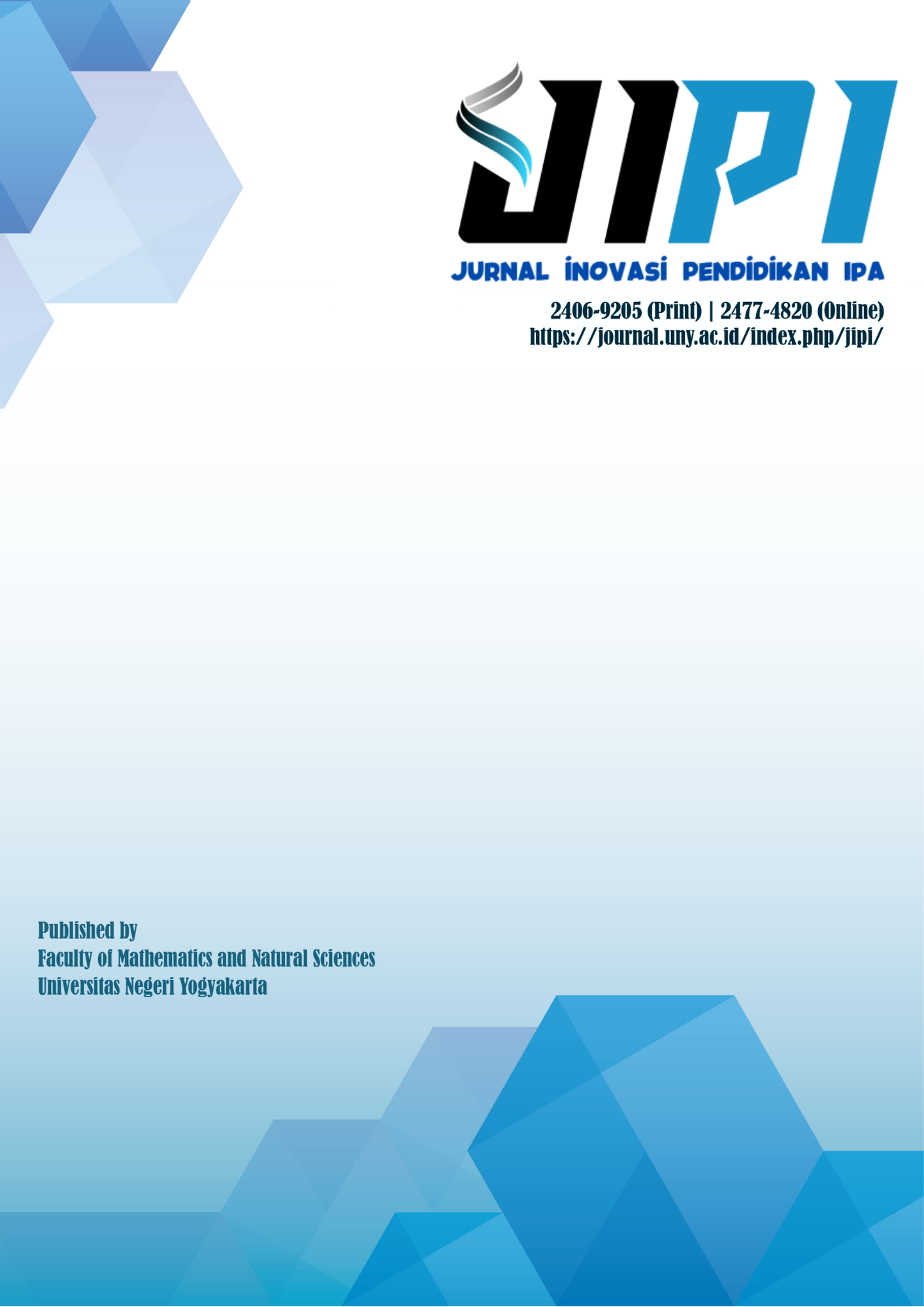Pengaruh model PBT terhadap kemampuan berpikir kritis dan kemampuan berpikir kreatif siswa SMAN 2 Magelang
DOI:
https://doi.org/10.21831/jipi.v2i1.8809Keywords:
use of problem-based teaching model, critical and creative thinking skillsAbstract
Penelitian ini bertujuan untuk mengetahui pengaruh model pembelajaran berdasarkan masalah terhadap kemampuan berpikir kritis dan pengaruh model pembelajaran berdasarkan masalah terhadap kemampuan berpikir kreatif siswa pada materi pencemaran lingkungan. Penelitian ini dilaksanakan di SMA Negeri 2 Magelang. Metode penelitian yang digunakan adalah kuasi eksperimen dengan desain nonrandomized control group pretest-posttest. Analisis data menggunakan uji t. Hasil perhitungan perbedaan rata-rata posttest pada kedua kelompok untuk kemampuan berpikir kritis menunjukkan nilai hitung sebesar 2,45 dan ttabel dengan signifikasi 0,05% dengan dk 62 = 2,00 sedangkan untuk kemampuan berpikir kreatif menunjukkan nilai hitung sebesar 3,43 dan ttabel dengan signifikansi 0,05% dengan dk 62 = 2,00. Hasil perhitungan tersebut menunjukkan bahwa thitung > ttabel. Hal ini berarti hipotesis alternatif (Ha) diterima dan hipotesis nol (H0) ditolak. Dengan demikian, terdapat pengaruh penggunaan model pembelajaran berdasarkan masalah terhadap kemampuan berpikir kritis dan terdapat pengaruh model Pembelajaran Berdasarkan Masalah terhadap kemampuan berpikir kreatif siswa pada konsep pencemaran lingkungan.
Kata Kunci: penggunaan model pembelajaran berdasarkan masalah, kemampuan berpikir kritis dan kemampuan berpikir kreatif.
The Effect of the Problem-Based Teaching Model on the Critical Thinking Skills and Creative Thinking Skills of the Students of SMA
Abstract
This study aimed to determine the effect of the use of problem-based teaching model on the critical thinking skills and effect of the use of problem-based teaching model on the creative thinking skills of students on environmental pollution materials. The research was conducted at SMAN 2 Magelang. The research method used was a quasi-experimental design with nonrandomized control group pretest-posttest. The data analysis used the t test. The result of the calculation of the posttest average of the difference between the two groups for critical thinking skills shows the calculated value of 2.45 and ttable with the significance level of 0.05% with 62 df = 2.00, while for the ability to think creatively the calculated value of 3.43 shows the ttable with the significance level of 0.05% with 62 df = 2.00. This shows that t > ttable. This means that the alternative hypothesis (Ha) is accepted and null hypothesis (H0) is rejected. Thus, there is an effect of the use of problem-based teaching model on the critical and creative thinking skills of the students on the concept of environmental pollution.
Keywords: use of problem-based teaching model, critical and creative thinking skills.References
Amir, T. M. (2009). Inovasi pendidikan melalui Problem Based Learning: Bagaimana pendidik memberdayakan pemelajar di era pengetahuan. Jakarta: Kencana Prenada Media Group.
Arends, R. I. (2008). Learning to teach. (Terjemahan Helly Prajitno Soetjipto & Sri Mulyantini Soetjipto). New York: McGraw Companies, Inc. (Buku asli diterbitkan tahun 2007).
Awang, H., & Ramly, I. (2008). Creative thinking skill approach through problem-based learning: Pedagogy and practice in the engineering classroom. Vol.3, no. 2, PP 33-38. Diambil tanggal 17 Juni 2013 dari: http//www.ijjssh.org/journal/20-H009.pdf.s
Bono, E. D. (2007). Revolusi berpikir: Belajar berpikir canggih dan kreatif dalam memecahkan masalah dan memantik ide-ide baru. (Terjemahan Sitompul, Ida & Fahmy Yamani). Bandung: Kaifa (Buku asli diterbitkan tahun 1993).
Brookhart, S. M. (2010). How to assess higher-order thinking skills in yours classroom. Virginia: ASCD Member Books.
Graaff & Kolmos (2003: 657). Defines the concept interms of specific attributes as being student centered, taking place in small groups with the teacher acting as a facilitators. Vol.2, no. 7, pp. 22-26. Diambil tanggal 17 Juni 2013. dari: http//www.pbl.org/journal/20-H009.pdf.s
Hargenhahn, B.R., & Olson, M.H. (2010). Theories of learning: Teori belajar edisi ketujuh. (Terjemahan Tri wibowo B.S). Jakarta: Kencana. (Buku asli diterbitkan tahun 2008).
Heong, Y.M., Othman, W. B., Yunos, J.B.M., Kiong, T.T., Hassan, R.B, & Mohamad, M.M.B. (2011): The level of marzano higher order thinking skills among thecnical education student. Vol. I, No. 2, PP 21-25. Diambil tanggal 17 Juni 2013 dari: http//www.ijjssh.org/journal/20-H009.pdf.
Huang, R. (2005). Chinese International Students'Perception of the Problem-Based Learning Experience. Vol.4, no. 2, PP 48-57. Diambil tanggal 18 Juni 2013 dari: http//www.pbl.pubs.aged/journal/20-H009.pdf.
Johnson, E. B. (2009). Contextual teaching & learning: Menjadikan kegiatan belajar-mengajar mengasyikkan dan bermakna. (Terjemahan Ibnu Setiawan). California: Corwin Press, Inc. (Buku asli diterbitkan tahun 2002).
Lyn, J. (2013). Higher Order Thinking Skills and Academic Performance in Physic Of College Students: A Regression Analysis. Vol.II, no. 4, PP 48-57. Diambil tanggal 18 Juni 2013 dari: http//www.ijjssh.org/journal/20-H009.pdf.
Ramizes, R.P.B., & Ganaden, M.S. (2008). College of education creative activities and students' higher order thinking skills. Education Quarterly Journal. Vol.II, no. 4, PP 48-57. Diambil tanggal 18 Juni 2013 dari: http//www.ijjssh.org/journal/20-H009.pdf.
Thomas, A., Thorne, G., & Small, B. (2000). Higher order thinking is thinking on a higher level than memorizing facst or telling something back to someone exactly the way the it was told to you. Diambil tanggal 17 Juni 2013. dari: http//www.ijjssh.pbl/journal/20-H009.pdf.
Trianto. (2010). Mendesain model pembelajaran inovatif-progresif: konsep, landasan, dan implementasinya pada kurikulum tingkat satuan pendidikan (KTSP) (edisi ke-satu). Jakarta: Kencana Prenada Media Group.
Downloads
Published
How to Cite
Issue
Section
Citation Check
License
The authors submitting a manuscript to this journal agree that, if accepted for publication, copyright publishing of the submission shall be assigned to Jurnal Inovasi Pendidikan IPA (JIPI). However, even though the journal asks for a copyright transfer, the authors retain (or are granted back) significant scholarly rights.
Jurnal Inovasi Pendidikan IPA by http://journal.uny.ac.id/index.php/jipi/index is licensed under a Creative Commons Attribution-ShareAlike 4.0 International License.










